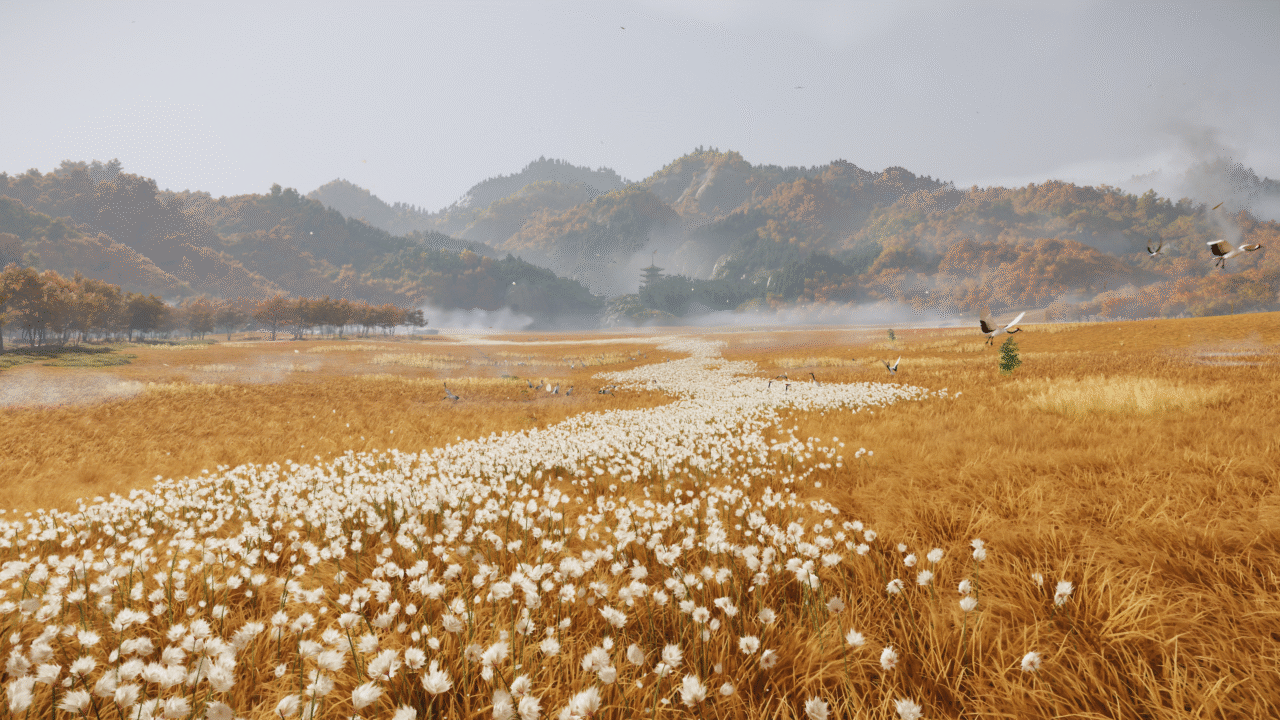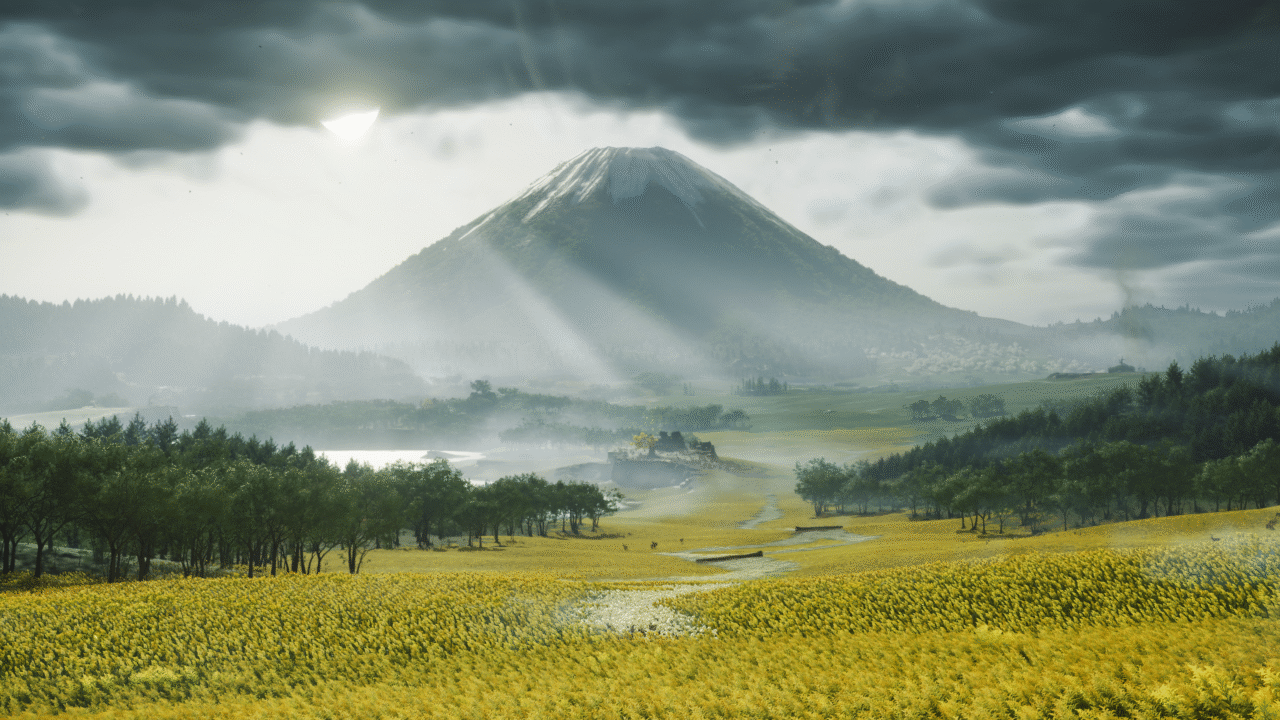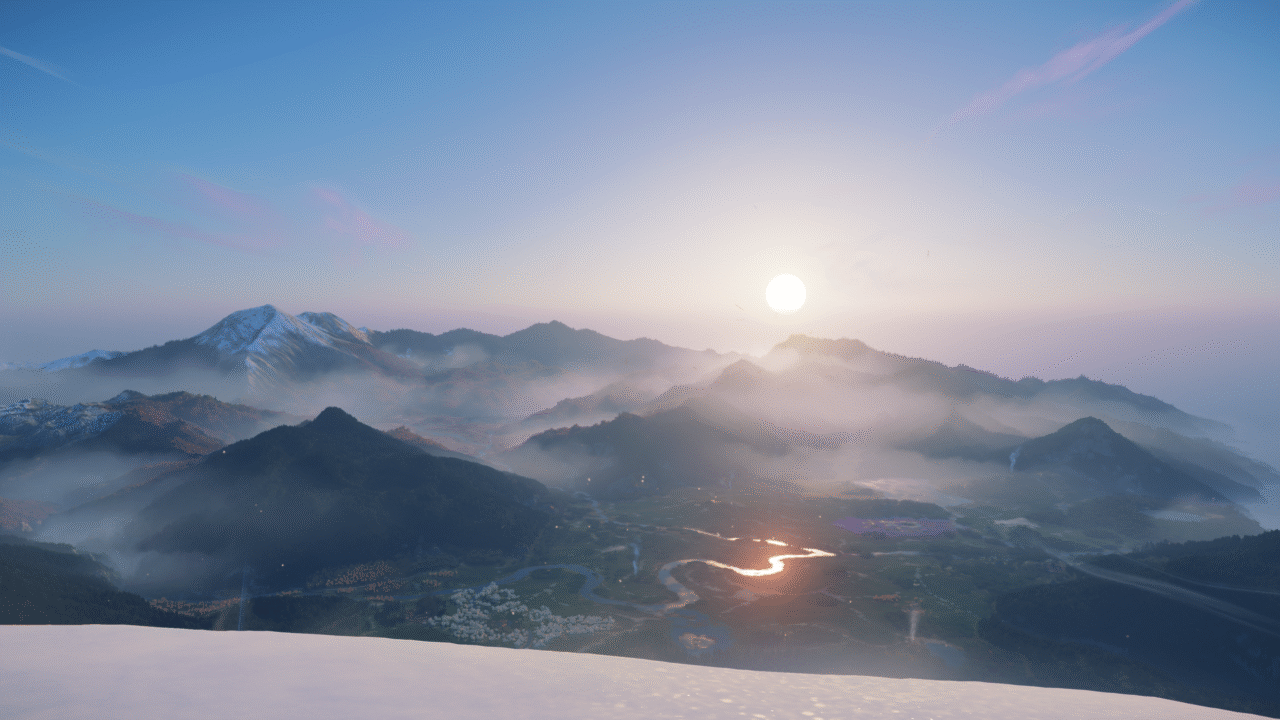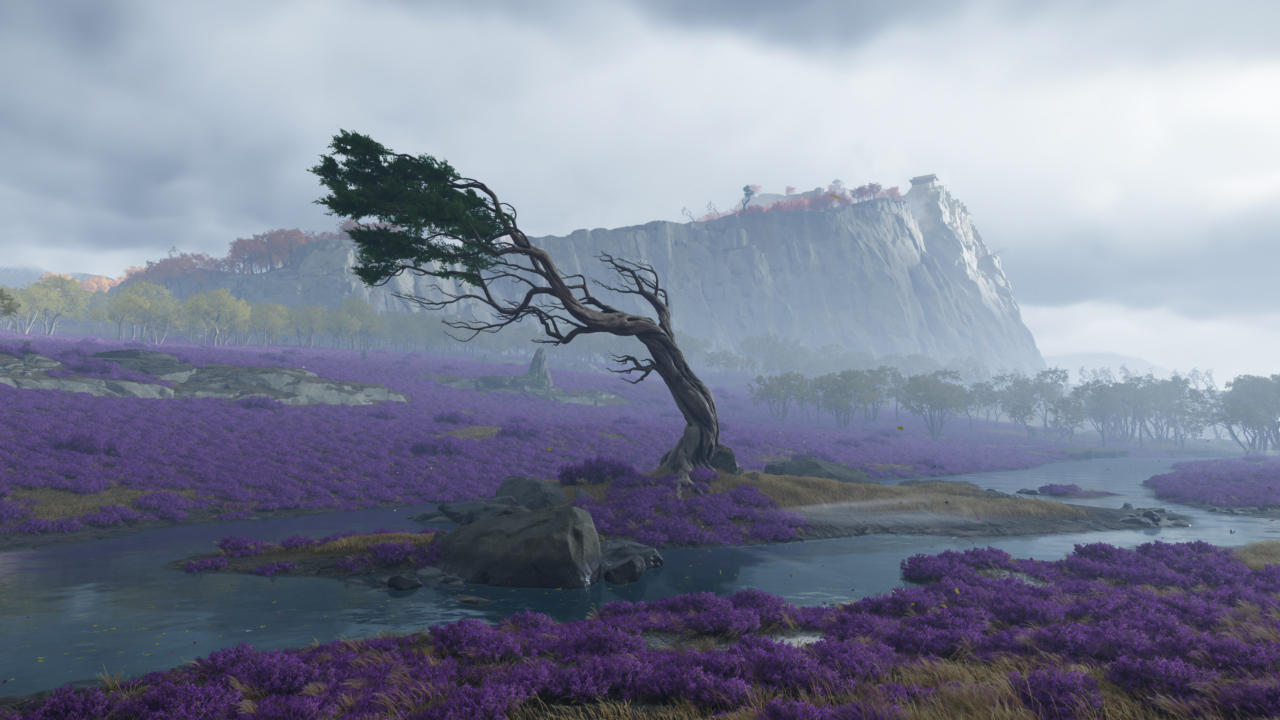
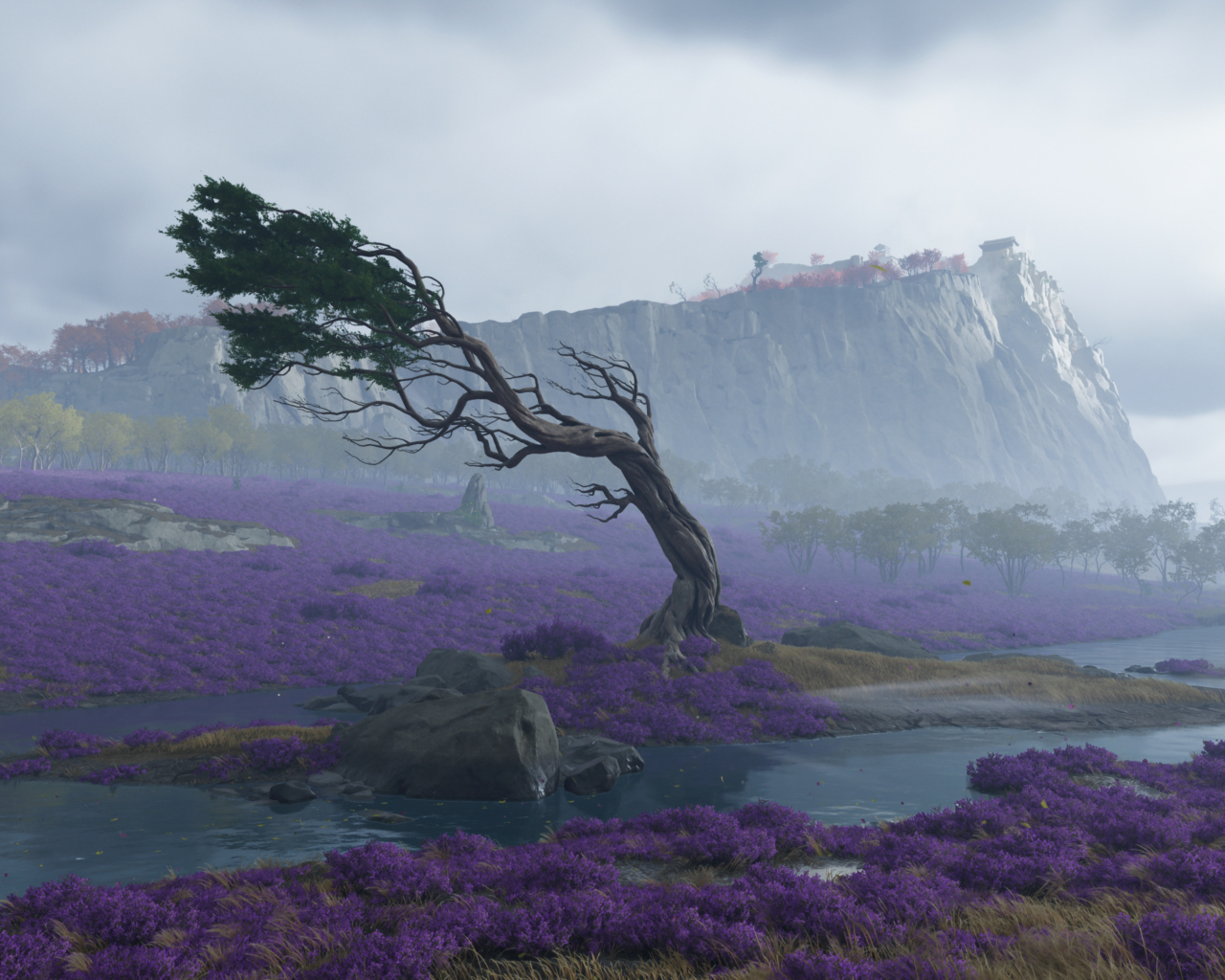
Graphics from Ghost of Yōtei by Sucker Punch Productions
words by lewis gordon
In Ghost of Yōtei, making camp is a small but significant activity. Within any of the game’s expansive areas—the lush yellow grasslands of Tokachi Range, for instance—you might stop to light a fire, mimicking the striking of flint by pushing up with your thumb on the controller’s motion pad before fanning its delicate flames by squeezing the shoulder button. Enjoying the warmth, your eyes wander upward, gazing upon the twinkling celestial order because, in the game’s setting of 17th-century Japan, light pollution hardly exists. Between the glowing embers in front of you and distant stars above, the stillness of the night fills the screen.
Ghost of Yōtei, released today on PlayStation 5, is the latest in a long line of video games depicting the natural world. Crude attempts were made in the 1980s, including Zelda’s first outing in 1986 and subsequent evolutions during gaming’s peak 16-bit era. Secret of Mana, released in 1993 for the SNES, featured intricately detailed trees and shrubs while Hirō Isono’s iconic box art for the game hinted at what the future might hold. A watershed moment arrived in 2005 with The Elder Scrolls IV: Oblivion. This early, open-world RPG featured miles of verdant hills carpeted with realistic trees and shrubs: one of the first instances of a video game inspiring wonder through nature rather than complex architectural geometry.
Now, the vast majority of blockbuster open-world video games are filled with myriad ecological biomes and teeming masses of flora. Like landscape painters before them, game makers have become obsessed with representing the complex, interlocking forms of organic life itself. But while the Death Stranding and Horizon franchises present pristine nature through post-apocalyptic sci-fi premises, Ghost of Yōtei—like 2018’s Red Dead Redemption 2—takes its cues from actual history.
The wilderness of Ghost of Yōtei, the sequel to 2020’s Ghost of Tsushima, appears photorealistic at first glance. In fact, this virtual version of Japan’s chilly northernmost island of Hokkaido is crafted with an artist’s eye. Playing as Atsu, a middle-aged woman seeking revenge against her family’s murderers, you gallop on horseback through slipstreams of petals, carried along by a great gusting wind as starling murmurations dance on distant updrafts. This evocative virtual world isn’t just a scenic backdrop for murderous action, nor primarily a tech showcase for Sony (which owns the studio behind the game, Sucker Punch Productions). The realm Atsu explores is supercharged with ecological symbolism and metaphor.
“The world itself is like a silent character, always standing behind you,” the game’s art director Joanna Wang, 46, told me over a video call.

There is no quieter, more stoic object in the game world than Mount Yōtei, the stratovolcano that towers over the player no matter where they are standing. At one point, Atsu—portrayed with steely, sensitive resolve by Erika Ishii—takes a bath in an onsen, one of the naturally occurring hot springs scattered throughout this part of Japan. She reflects on the mountain as she relaxes, referring to it as the “she-mountain,” seeming to draw strength from its isolated yet immovable shape.
The analogy is well earned, said co-creative director Jason Connell. Like the mountain, “she’s got this lonely aspect, but isn’t going down easy,” he said.
Connell, a bearded, casually dressed 42-year-old, grew up in a small Alaskan village called Girdwood. He regularly encountered bears and moose, and also went fishing on the weekends. Now he’s based in the coastal town of Monterey in California, less rugged than Alaska but similarly abundant. When he’s not helming a video game, the creative director is outside with his children, a 6-year-old and a 4-year-old, observing, respecting, and playing amid nature—among other activities, looking at bugs and foraging for mushrooms. Connell also dabbles in landscape photography. “I find beauty in [nature’s] raw amount of color,” he said.
Ghost of Yōtei bears this influence. Its landscapes pop with vivid hues: screen-wide washes of single tints derived from the fields and meadows of native Japanese plants like red spider lilies and blue nemophila flowers. Sunlight and moonlight dance off these plants—psychedelic in their hyper-detail and radiance. The colors are so striking in part because of an approach borrowed from photography: to ensure the light is as clear as possible. Adding haze or colored filters, even in subtle ways, would “crush” the natural colors, said Connell. “The vibrancy of the local vegetation would be dulled.”
Connell draws inspiration from Akira Kurosawa movies: works that “celebrate the motion of the wind, rain, and grass,” he said. The splatter of red blood upon white snow, a favorite image of the famed film director, is also a visual theme in the game.
But one more understated touchstone is traditional Japanese woodblock printing by artists like Utagawa Hiroshige and, of course, Katsushika Hokusai, the printmaker behind the Great Wave. This art style frequently exaggerates plant shapes. Stalks and leaves curve over, said Wang, gesturing on camera, shaping her arms downward as if she herself were a plant. “You feel a little bit of emotion in even a single leaf,” she said. “And when we repeat that in a very large field, the feeling is amplified.”
All told, one frame of the game can contain tens of thousands of plants. Each blade of grass is rendered as a single piece of rigged geometry that is later animated to interact with the simulated wind. Amid this billowing scenery, Wang and a team of artists and technical artists add leaves, dust, smoke, fog, and pollen—more than 250,000 at any one moment swirling from the foreground to the far distance. When the weather conditions are at their most volatile—the wind roiling and light glinting from the sky at the perfect angle—Ghost of Yōtei feels sublimely symphonic.

The wind itself is the result of some canny and complicated math. Vectors simulate currents of air pushing across the landscape, their magnitudes modulated using a CGI technique called Perlin noise. Systems of airborne objects like leaves and dust are then layered on top of these vectors, generating blustery flurries. The system is complex—inscrutable to anyone but a graphics whizz—yet the output is instantly apparent: a setting that swirls with the gale-force drama of protagonist Atsu and the politics of the land writ large; pathetic fallacy conceived in both personal and panoramic terms.
The year that the game takes place, 1603, is a pivotal moment for these politics. This is when the Tokugawa Shogunate was formed by Tokugawa Ieyasu, putting an end to decades of civil war. Hokkaido was a rugged and sparsely populated home to Indigenous Ainu people that, in the coming years, experienced a gradual colonial takeover by southern forces. We bear witness to these changes being wrought on the landscape: newly erected wooden fortifications alongside masses of stubby, felled trees. In the western Ishikari Plain, the fire of warfare lights up the sky: a brighter, more intense orange than the autumnal vegetation. At another onsen, Atsu, reflecting on the changing demographics of Hokkaido, says, “I can see the south in its people.”
The game’s chief antagonist, Lord Saito, is hellbent on culling the wolves still living on the island, a means of him “taming” the region—extending fascistic power over ecology and society. One of these lupine creatures strikes up a bond with Atsu, frequently joining her in battle, sinking its teeth into the flesh of her—and its—foes. Connell sees the two characters as “deeply paralleled” in the sense that they are both “forces of nature,” he said, ripping across the land like one of the game’s turbulent weather fronts. Atsu herself is a distinctly modern hero: frequently denigrated by men for being a woman (criticisms she curtly bats away) while also possessing an innate sense of environmental justice. There is no denying the deep catharsis of cleaving her katana through the men colonizing this place and its people.

The history of video games is rife with game makers employing nature to artistic ends. Showcases for video game engines typically focus on the ways technicians and engineers can mimic environmental forces with ever-greater verisimilitude: light, physics, foliage, water, rain, rock. Critics of video games commonly blame them for young people’s rising apathy toward the outside world. But ecological phenomena are beamed into the home in ever-more wondrous configurations—and there is evidence to suggest this simulation can provide, if not equal psychological benefits, then something comparable.
Such hyperrealistic depictions of nature are, of course, used by corporations to sell services. Nearly every Ghost of Yōtei trailer and promotional image features the ginkgo tree, a famously resilient shrub with rich, lemon-yellow leaves. But Connell, Wang, and their colleagues do not invoke it shallowly. Ginkgo becomes the defining leitmotif for Atsu’s personal odyssey. “You can cut that thing down, set it on fire, whatever, and there’s a chance it’ll come back,” said Connell. The co-creative director likens Ghost of Yōtei’s use of nature to Hayao Miyazaki’s 1997 anime classic, Princess Mononoke, “almost like a support structure inside the film,” he said. Both movie and game prominently feature wolves, now extinct in Japan. These animals are, in essence, historical artifacts—and because of this, they carry in their being a wistful sadness, the sense of an age which has definitively passed.
The name, Ghost of Yōtei, is also telling. Atsu is seen by many in the game as an onryō, a vengeful folkloric spirit who haunts Hokkaido. But in this video game, the land itself is something of a specter, a reanimated version of a place and people which does not exist in nearly such abundance. In this way, Ghost of Yōtei lives up to its title: Here is a video game that doubles as an elegy.
This Year’s Most Anticipated Video Game Is an Homage—and Elegy—to Nature
